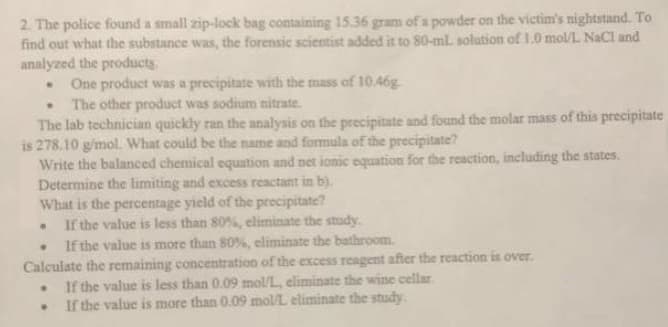2. The police found a small zip-lock bag containing 15.36 gram of a powder on the victim's nightstand. To find out what the substance was, the forensic scientist added it to 80-ml solution of 1.0 mol/L. NaCl and analyzed the products. . One product was a precipitate with the mass of 10.46g . The other product was sodium nitrate. The lab technician quickly ran the analysis on the precipitate and found the molar mass of this precipitate is 278.10 g/mol. What could be the name and formula of the precipitate? Write the balanced chemical equation and net ionic equation for the reaction, including the states. Determine the limiting and excess reactant in b).
2. The police found a small zip-lock bag containing 15.36 gram of a powder on the victim's nightstand. To find out what the substance was, the forensic scientist added it to 80-ml solution of 1.0 mol/L. NaCl and analyzed the products. . One product was a precipitate with the mass of 10.46g . The other product was sodium nitrate. The lab technician quickly ran the analysis on the precipitate and found the molar mass of this precipitate is 278.10 g/mol. What could be the name and formula of the precipitate? Write the balanced chemical equation and net ionic equation for the reaction, including the states. Determine the limiting and excess reactant in b).
Chapter79: Solubility
Section: Chapter Questions
Problem 1P
Related questions
Question

Transcribed Image Text:2. The police found a small zip-lock bag containing 15.36 gram of a powder on the victim's nightstand. To
find out what the substance was, the forensic scientist added it to 80-ml solution of 1.0 mol/L NaCl and
analyzed the products.
One product was a precipitate with the mass of 10.46g
.
The other product was sodium nitrate.
The lab technician quickly ran the analysis on the precipitate and found the molar mass of this precipitate
is 278.10 g/mol. What could be the name and formula of the precipitate?
Write the balanced chemical equation and net ionic equation for the reaction, including the states.
Determine the limiting and excess reactant in b).
What is the percentage yield of the precipitate?
.
If the value is less than 80%, eliminate the study.
.
If the value is more than 80%, eliminate the bathroom.
Calculate the remaining concentration of the excess reagent after the reaction is over.
.
If the value is less than 0.09 mol/L, eliminate the wine cellar
.
If the value is more than 0.09 mol/L eliminate the study.
Expert Solution
This question has been solved!
Explore an expertly crafted, step-by-step solution for a thorough understanding of key concepts.
Step by step
Solved in 7 steps

Knowledge Booster
Learn more about
Need a deep-dive on the concept behind this application? Look no further. Learn more about this topic, chemistry and related others by exploring similar questions and additional content below.Recommended textbooks for you

EBK A SMALL SCALE APPROACH TO ORGANIC L
Chemistry
ISBN:
9781305446021
Author:
Lampman
Publisher:
CENGAGE LEARNING - CONSIGNMENT

Chemistry: An Atoms First Approach
Chemistry
ISBN:
9781305079243
Author:
Steven S. Zumdahl, Susan A. Zumdahl
Publisher:
Cengage Learning


EBK A SMALL SCALE APPROACH TO ORGANIC L
Chemistry
ISBN:
9781305446021
Author:
Lampman
Publisher:
CENGAGE LEARNING - CONSIGNMENT

Chemistry: An Atoms First Approach
Chemistry
ISBN:
9781305079243
Author:
Steven S. Zumdahl, Susan A. Zumdahl
Publisher:
Cengage Learning


Chemistry
Chemistry
ISBN:
9781305957404
Author:
Steven S. Zumdahl, Susan A. Zumdahl, Donald J. DeCoste
Publisher:
Cengage Learning

Principles of Modern Chemistry
Chemistry
ISBN:
9781305079113
Author:
David W. Oxtoby, H. Pat Gillis, Laurie J. Butler
Publisher:
Cengage Learning